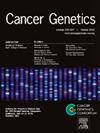A pilot study of evaluation of a deep-learning-based homologous recombination deficiency assay in korean patients with ovarian high-grade serous carcinoma: Diagnostic performance and clinical implications
IF 2.1
4区 医学
Q4 GENETICS & HEREDITY
引用次数: 0
Abstract
Background
Homologous recombination deficiency (HRD)-related genetic mutations in ovarian high-grade serous carcinoma (HGSC) are known to be ethnic specific. Here, we assessed the diagnostic performance of HRD and its clinical implication in Korean HGSC patients using the SOPHiA DDM HRD Solution.
Methods
Sixty-three ovarian cancer (OC) patients were enrolled, including 53 with HGSC and 10 with other subtypes. HRD status was determined by 28 homologous recombination repair (HRR) genetic sequencing and genomic scarring (GS) measurement. The GS was measured through low-pass whole-genome sequencing and quantified using the genomic integrity index (GII).
Results
HRD status was analyzed in 53 out of 63 OC patients (84.1 %). Among the 53 with HGSC, HRD results were available for 83.0 % (n = 44). Of these HGSC patients, 72.7 % (n = 32) were HRD-positive, including 15 with BRCA1/2 mutations (34.1 %) and 27 with GI-positive (61.4 %). In HGSC, HRD-positive status was associated with solid, pseudoendometrioid or transitional (SET) pattern (P = 0.015). Patients with positive HRD and high GII (>4.2) exhibited improved disease-free survival (DFS) and overall survival (OS) compared to those with negative HRD (P = 0.003 and 0.024, respectively) and low GII (P < 0.001 and P = 0.006, respectively). Multivariate analysis revealed a high GII as a better prognostic indicator for DFS and OS (P = 0.003 and 0.032, respectively).
Conclusion
The HRD assay offers high diagnostic performance of HRD in Korean OC patients. Furthermore, the prognostic value of high GII and HRD, as well as an association with SET pattern and HRD was evident in HGSC.
一项评估基于深度学习的同源重组缺陷测定在韩国卵巢高级别浆液性癌患者中的初步研究:诊断性能和临床意义
背景:已知卵巢高级别浆液性癌(HGSC)中同源重组缺陷(HRD)相关基因突变具有种族特异性。在这里,我们使用SOPHiA DDM HRD溶液评估韩国HGSC患者HRD的诊断性能及其临床意义。方法纳入63例卵巢癌(OC)患者,其中HGSC 53例,其他亚型10例。通过28个同源重组修复(HRR)基因测序和基因组疤痕(GS)测量来确定HRD状态。GS通过低通全基因组测序测量,并使用基因组完整性指数(GII)进行量化。结果63例OC患者中有53例(84.1%)存在shrd状况。在53例HGSC患者中,HRD结果为83.0% (n = 44)。在这些HGSC患者中,72.7% (n = 32)为hdd阳性,包括15例BRCA1/2突变(34.1%)和27例gi阳性(61.4%)。在HGSC中,hrd阳性状态与实性、假子宫内膜样或移行性(SET)模式相关(P = 0.015)。与HRD阴性患者(P = 0.003和0.024)和低GII患者(P <; 0.001和P = 0.006)相比,HRD阳性和高GII患者(>4.2)表现出更好的无病生存(DFS)和总生存(OS)。多因素分析显示,高GII是DFS和OS更好的预后指标(P分别= 0.003和0.032)。结论HRD检测对韩国OC患者的HRD有较高的诊断价值。此外,高GII和HRD的预后价值,以及与SET模式和HRD的关联在HGSC中是明显的。
本文章由计算机程序翻译,如有差异,请以英文原文为准。
求助全文
约1分钟内获得全文
求助全文
来源期刊

Cancer Genetics
ONCOLOGY-GENETICS & HEREDITY
CiteScore
3.20
自引率
5.30%
发文量
167
审稿时长
27 days
期刊介绍:
The aim of Cancer Genetics is to publish high quality scientific papers on the cellular, genetic and molecular aspects of cancer, including cancer predisposition and clinical diagnostic applications. Specific areas of interest include descriptions of new chromosomal, molecular or epigenetic alterations in benign and malignant diseases; novel laboratory approaches for identification and characterization of chromosomal rearrangements or genomic alterations in cancer cells; correlation of genetic changes with pathology and clinical presentation; and the molecular genetics of cancer predisposition. To reach a basic science and clinical multidisciplinary audience, we welcome original full-length articles, reviews, meeting summaries, brief reports, and letters to the editor.
 求助内容:
求助内容: 应助结果提醒方式:
应助结果提醒方式:


